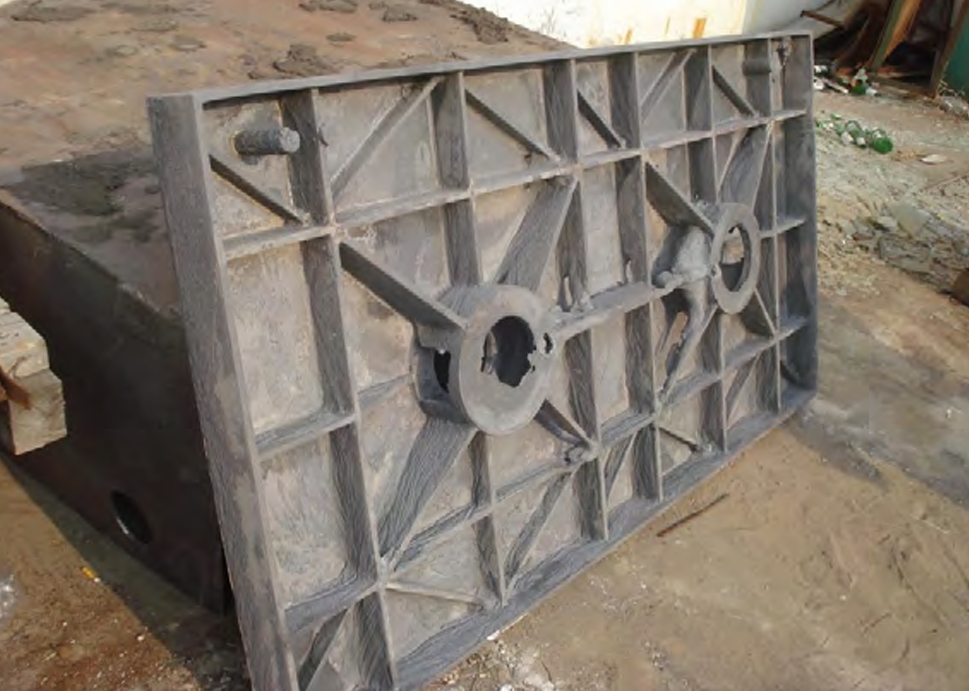Large castings serve as fundamental components in heavy industrial equipment, where dimensional stability and structural integrity directly impact operational precision. As critical weight-bearing elements in machine tools, bed plates exhibit significant challenges during manufacturing due to their massive dimensions—typically ranging from 20 to 50 tons. Historically, these large castings suffered from internal shrinkage defects detected during post-machining drilling operations, particularly within 70mm of the upper surface in central regions. Such defects manifested as dendritic cavities in cross-sections, compromising mechanical performance and causing substantial economic losses through scrap rates exceeding 30% in severe cases. The following sections detail comprehensive process optimizations that eliminated these defects while establishing reliable production parameters for large castings.
Initial manufacturing employed a top-bottom mold configuration using resin sand molds, with single-side gating systems feeding gray iron (HT200-300). Typical process parameters included pouring temperatures of 1470–1480°C and carbon equivalent (CE) values maintained at hypoeutectic levels (3.60–3.70%). The carbon equivalent is calculated as:
$$CE = C + \frac{1}{3}(Si + P)$$
where C, Si, and P represent weight percentages of carbon, silicon, and phosphorus respectively. Despite apparent mold filling adequacy, ultrasonic testing and machining revealed subsurface shrinkage porosity exceeding 5mm diameter in critical zones, attributable to inadequate feeding during solidification. The solidification time for such large castings follows Chvorinov’s rule:
$$t = k \left( \frac{V}{A} \right)^2$$
where \(t\) is solidification time, \(k\) is mold constant, \(V\) is volume, and \(A\) is surface area. For the original geometry (2500×4600×340 mm), this yielded extended solidification periods exceeding riser effectiveness.
| Original Casting Parameters | ||
|---|---|---|
| Material | HT200-300 | Gray Iron |
| Pouring Temperature | 1470–1480°C | Single-side |
| Carbon Equivalent (CE) | 3.60–3.70% | Hypoeutectic |
| Riser Efficiency | 12–15% | Insufficient feeding |
Comprehensive Process Improvements
Metallurgical Optimization
Carbon equivalent elevation to hypereutectic levels (4.55%) significantly reduced shrinkage tendency by modifying solidification morphology. Hypereutectic compositions promote graphite expansion during eutectic reaction, counteracting liquid contraction. The phase stability is governed by:
$$\Delta G = \Delta H – T\Delta S < 0$$
where \(\Delta G\) is Gibbs free energy, \(\Delta H\) is enthalpy change, \(T\) is temperature, and \(\Delta S\) is entropy change. Higher CE values decrease undercooling, facilitating type-A graphite formation while suppressing Fe3C precipitation that exacerbates shrinkage.
Thermal Management
Pouring temperature reduction to 1320–1340°C was achieved through:
- Lowering furnace tap temperature to 1450–1460°C
- Increasing nodulizer coverage from 2.0% to 2.0–2.5%
This reduced total solidification shrinkage (\(\epsilon\)) described by:
$$\epsilon = \alpha_v \Delta T + \beta$$
where \(\alpha_v\) is volumetric thermal contraction coefficient, \(\Delta T\) is temperature drop, and \(\beta\) is phase change contraction. Temperature reduction decreased \(\Delta T\) by 150°C, lowering \(\epsilon\) by approximately 2.3%.
Gating and Feeding System Redesign
Transition from single to double-sided gating halved metal flow distance, reducing turbulence and temperature gradient (\(\nabla T\)) across the large casting. The modified system satisfied Bernoulli’s principle:
$$\frac{v_1^2}{2g} + \frac{p_1}{\rho g} + z_1 = \frac{v_2^2}{2g} + \frac{p_2}{\rho g} + z_2$$
where \(v\) is velocity, \(p\) is pressure, \(\rho\) is density, \(g\) is gravity, and \(z\) is elevation. Simultaneously, riser dimensions were increased by 40% to ensure:
$$M_R \geq 1.2 M_C$$
where \(M_R\) and \(M_C\) are riser and casting moduli (\(M = V/A\)). Riser placement followed feeding distance rules:
$$L_{max} = 6\sqrt{T}$$
where \(L_{max}\) is maximum feeding distance (cm) and \(T\) is section thickness (cm).
| Process Parameter | Original | Optimized | Improvement |
|---|---|---|---|
| CE Value (%) | 3.60–3.70 | 4.55 | +26% |
| Pouring Temp (°C) | 1470–1480 | 1320–1340 | -150°C |
| Feeding Duration (min) | 20 | 30–40 | +50–100% |
| Gating Configuration | Unilateral | Bilateral | Flow path halved |
Advanced Feeding Technique
Implementation of separate high-temperature iron (1420°C) for prolonged feeding extended thermal gradient maintenance. The feeding time-temperature integral was enhanced from 26,400°C·min to over 52,800°C·min, satisfying Niyama’s criterion for shrinkage prevention:
$$G/\sqrt{\dot{T}} \geq \kappa$$
where \(G\) is thermal gradient, \(\dot{T}\) is cooling rate, and \(\kappa\) is alloy-dependent constant. Strategic placement of graphite blocks improved directional solidification, with chill optimization governed by Fourier’s law:
$$q = -k \nabla T$$
Validation and Implementation

Post-implementation analysis of drilled sections confirmed complete elimination of shrinkage defects across 12 consecutive productions. Metallographic examination revealed type-A graphite distribution exceeding 90% with pearlite content below 10%, satisfying ASTM A48 hardness requirements of 200-300 HB. The optimized process achieved zero scrap rate over 18 months of production, reducing manufacturing costs by 23% through material conservation and eliminated rework. Production throughput increased by 17% due to eliminated quality delays.
Conclusion
Large casting integrity depends on synergistic control of metallurgical, thermal, and hydrodynamic factors. Hyper-eutectic carbon equivalent elevation fundamentally modifies solidification dynamics, while reduced pouring temperatures diminish total contraction volume. Bilateral gating ensures thermal homogeneity across massive sections, and extended feeding with high-temperature metal sustains critical thermal gradients. These principles establish a robust framework for heavy-section casting production, directly applicable to other large casting geometries exceeding 20-ton mass. Implementation has transformed bed plate manufacturing from problematic to predictably reliable, demonstrating that systematic process optimization can overcome inherent challenges in large casting production.
